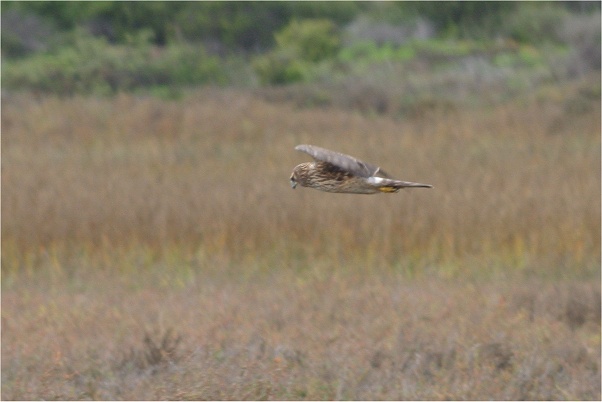
Location: Tijuana River Valley Estuary, Imperial Beach, CA
Date: 2004-12-31
Lens: Canon 400mm F5.6

 Northern Harrier
Circus cyaneus
Northern Harrier
Circus cyaneus
 Description
DescriptionNorthern Harrier's have the characteristic feature of flying low to the ground with their wings held in a nearly flat "V" shape. The bird hunts by systematically flying back and forth in a pattern known as "quartering". Its prey, consisting of mostly rodents and small birds, is detected using extremely sensitive hearing. This is different from other hawks, which primarily use sight for hunting. The harrier has exceptionally large ear openings that are concealed behind an owllike facial disk.
General: 16 to 24 inches in length. Facial disk, similar to an owl.
Adult Male: Pale gray plumage. Head darker gray than body. Underparts paler than upperparts. White rump. Black wing tips. Narrow dark bars on gray tail. Short, yellowish or dark hooked beak with dark tip. Yellow eyes and legs.
Adult Female: Dark brown upperparts. Buff underparts with darker streaks on breast, belly, and underwing coverts. Dark barring on flight feathers. White rump. Narrow dark bars on tail. Short, yellowish or dark hooked beak with dark tip. Has brown eyes that turn yellow at around three years of age. Larger than the male. Yellow legs.
Juvenile: Similar to adult female, except its head is streaked with dark brown and its underparts are orange-buff colored and streakless. Grayish eyes.
Open grasslands, fields, and marshes.
 Nesting
Nesting4 or 5 pale blue or white eggs, either unmarked or with light brown spots. The eggs have a 30-32 day incubation period. Fledging occurs at 30-41 days. The nest is a flimsy structure of sticks and grass built on the ground.